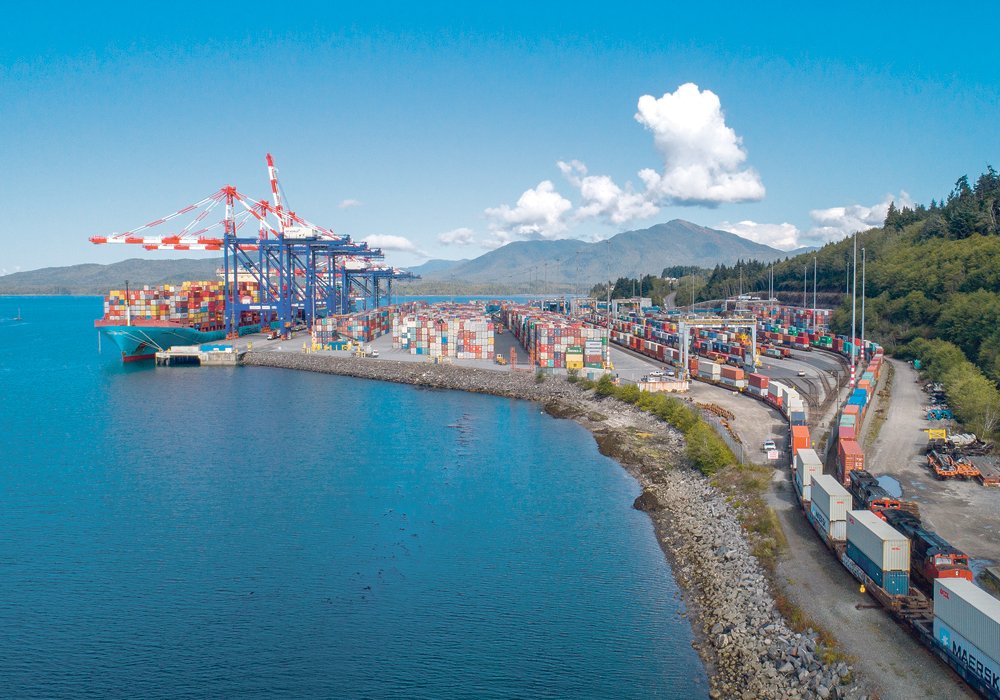Agricultural products comprised 32 percent of the shipping containers that moved through the B.C. port last year
The Port of Prince Rupert in northern British Columbia celebrated a historic milestone last month.
It moved its millionth 20-foot equivalent (TEU) shipping container of the 2018 calendar year through the port’s recently expanded Fairview Container Terminal.
The container was filled with dimensional lumber from Canfor and was moved by rail to the Fairview terminal before being loaded onto the ocean vessel COSCO Africa on Dec. 18.
“Reaching one million TEUs in a calendar year is an exciting milestone,” said Port of Prince Rupert president and chief executive officer Shaun Stevenson.
Read Also

Farming Smarter receives financial boost from Alberta government for potato research
Farming Smarter near Lethbridge got a boost to its research equipment, thanks to the Alberta government’s increase in funding for research associations.
“We’re the third largest container port in Canada and we have the second largest container terminal in Canada, so we’re a small community with a big port.”
Just a few years ago, the thought of handling a million TEU containers per year was considered far beyond the port’s capabilities.
But terminal expansions and other infrastructure projects at Prince Rupert have allowed the port to significantly expand its container handlings.
Prince Rupert’s Fairview Container Terminal opened in 2007 and handled about 182,000 containers in its first full year of operation.
An ambitious expansion project that was completed in 2017 boosted Fairview’s capacity to about 1.35 million TEUs and another expansion expected to start in 2019 will push the terminal’s annual capacity to around 1.8 million TEUs, Stevenson said.
“We’ve got plans to take the terminal up to about 2.7 million TEUs that are already through the environmental assessment process,” he said.
“And we’re doing further planning right now that’s looking at what Prince Rupert could do in the future to boost (annual container movements) up to four, five or maybe six million TEUs to respond to growing market demand.”
In a recent interview, Stevenson said agricultural exports represent a growing portion of the terminal’s containerized handlings.
Agricultural products accounted for 66,500 TEUs or 32 percent of the port’s total containerized exports in 2018.
A year earlier, in 2017, containerized agricultural products accounted for 34,512 TEUs, or roughly 21 percent of the port’s total containerized exports.
“Containerized ag products have typically been specialty crops, pulses, cubes, pellets and things like that,” Stevenson said.
“But what we’re seeing growth in recently is more conventional grains and oilseeds … and some soybeans as well.”
Until recently, most Canadian agricultural products that were shipped in containers through Prince Rupert were been stuffed at inland transloading facilities.
But in August of 2017, Montreal-based Ray Mont Logistics opened a new transloading facility at the port, a move that significantly altered the economics of container shipping.
Today, agricultural products grown on the Prairies can be shipped as bulk cargoes on unit trains, containerized at the port and loaded quickly onto outgoing vessels.
“It (Ray Mont’s presence) was a real innovation the supply chain,” said Stevenson.
It allowed agricultural shippers to take advantage of the transportation economics that unit trains represent while enabling them to capture the additional value that’s normally associated with containerized products.
Monika Cote, communications co-ordinator for the port authority, said the growth of Fairview Terminal represents a major opportunity for Canadian agricultural exporters.
Ray Mont’s operations are “a major success story for the port and small grain producers alike,” she added.
The anticipated opening of a new Intermobil container terminal east of Regina will provide additional options for agricultural shippers in southern Saskatchewan.
The Intermobil terminal is expected to be operational in the first half of 2019.
Between containerized shipments and bulk agricultural cargoes that are handled by the Prince Rupert Grain terminal, agricultural commodities now make up one third of Prince Rupert’s annual exports.


















